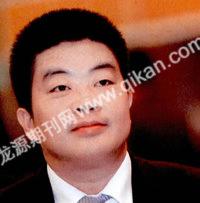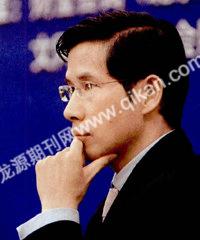A Chinese Commercial Giant in the Making?
By staff reporter ZHANG XUEYING
AT the 2008 Summer Davos Forum held in Tianjin, China Today saw Feng Jun spare no effort in demonstrating his products to visitors. At that moment, it was really difficult to imagine he was the CEO of Beijing Huaqi (Aigo) Information Digital Technology Co., Ltd.
In 1993 Feng Jun started a business selling computer boxes and keyboards. Now the Chinese market share of Aigos MP3 players is twice that of Samsung and ten times that of Sony. Its MP4 player sales rank first on the Chinese mainland, and the company has produced the highest selling USB flash drives on the Chinese market for eight consecutive years. Aigo also has branches in six other countries, such as France, Singapore and India. This medium-sized firm with only 1,900 staff is increasing its sales by 60 percent annually.

Over the past 37 years, attendees at the Davos Forum have mostly been CEOs from the worlds top 500 enterprises. But Mr. Klaus Schwab, founder of the forum, understands that the development of the worlds economy is not only decided by these large enterprises. More and more growth-oriented newly emerging multinationals are developing at a fast pace in the global market. In recent years, the organizers of the forum started to notice these “Young Global Leaders.” Feng in particular stood out.
“These young leaders share common characteristics, in that they are creative and have pioneering spirit. They change peoples lives by inventing new products and offering new services. They promote economic growth,” says Hu Zuliu, managing director of Goldman Sachs (Asia) L.L.C.
The newest Aigo product is the Aigo MID. “It is thinner than a coin and lighter than a bottle of water,” says Feng. This small square gadget enables users to visit websites, share videos, receive and send emails, chat via QQ, do online shopping, and more. In contrast to accessing the Internet via cell phones, MID users can not only read emails, but also write and send them. In addition, users can buy goods online, not just browse products. And it has another unique advantage — translate English and Chinese photographed text. According to Feng, Aigo is always striving to make its products more convenient.
Aigos MID completely changed the mind of critics who had charged that the company was not creative enough. Feng told China Today: “Aigo invests 80 percent of its annual profits in research and development (R&D;) every year, which is almost impossible in many other companies. We now own over 600 patents, with more than 200 invented by ourselves. The president of Intel is very interested in Aigo MID. Not long ago he came to China and discussed the possibility of cooperation with us. Aigos MID was the first to be able to translate photographed text. The iphone producers feel rather nervous now because they consider our MID to be a major rival,” Feng says proudly.
Another product favored by Feng is the “Aigo Aifly Wonder-Pen.” The Wonder-Pen, says Feng, is an example of the kind of innovation he hopes will eventually transform his company into a Chinese Sony. Equipped with fetching white earphones, the pen plays sound files when its electronic nib is pressed against paper printed with special invisible ink. It can turn an ordinary-looking museum guidebook into an interactive experience, with readers able to hear detailed spoken explanations simply by tapping the books photographs. “Its a unique product using unique technology,” enthuses Feng.
Aigo is not concerned about the global slowdown because it keeps putting new products on market. An Aigo official told us that although its sales goals have been lowered this year, the company may still maintain a growthof 50 percent.
The rapid growth of the Chinese economy has accounted for over 15 percent of the worlds economic growth. Chinese government leaders anxious to reduce Chinas reliance on foreign technology and design have made the building of national R&D; resources a cornerstone of industrial policy. Spending on R&D; in China increased by a “stunning” 19 percent a year in the decade after 1995. In recent years, the spending on R&D; has doubled to account for 1.5 percent of gross domestic product (GDP), a level surpassing even Japan. However, according to some analysts, China cannot be a threat to the technological superiority of the U.S., Japan and the European Union in the near future.

“Most Chinese companies are cramped by factors such as funds, operation scale and quality of staff, so they lag far behind companies in the U.S., Japan and the European Union in creativity. However, compared to those well-established old brands, our company is young. We can do as well as they have done, or even better, as long as we try our utmost. This is our experience with the success of our MP3 players,” says Feng.
In August 2002, the first Aigo MP3 players appeared on the market. Before that, players made in ROK occupied a dominant position in China. But all of them had a fatal weakness in that they required the installation of a driver before use. In addition, they needed special connectors to use with computers. At that time, Aigo, which was already Chinas largest USB flash drive supplier, combined the technologies of mobile storage and MP3 players, realizing a plug and play function. “We tried to make things easier for our consumers, and I think that is enough,” explains Feng.
Early this decade, Feng received news that the sales of Aigo MP3 players had surpassed that of Samsung in less than eight months. In 2004, Aigo took the initiative in producing color screen MP3 players at a price almost equal to Samsungs black and white products. Again Aigo left Samsung far behind and retained its leading position in the domestic market. “We are determined to move ahead of Samsung. If they produce color screen players, we will produce a visual display screen player,” states Feng.
Aigo MP3 players can now be seen everywhere in the overseas market, including Europe, Singapore and India. Aigo now occupies third place in the Singapore market. In Britain, its market share now places it second. “If Western companies should be scared of anyone in China, it is Feng Jun,” reported the Financial Times.
Aigo is not the only Chinese enterprise rapidly emerging on the international market. In the past five years, many Chinese hi-tech companies have grown rapidly and gathered strength, including the world famous Lenovo Group Ltd.; Bai Du, known as the Chinese Google; Alibaba, known for e-commerce; and Shanda Entertainment, known for its Internet games service.
The GEM Global Report 2006 produced by the Global Entrepreneurship Monitor (GEM) showed that the number of start-ups and entrepreneurial activity reached a new high in China that year. The countrys total early-stage entrepreneurial activity or TEA-index stood at 16.2 percent, ranking sixth among the 42 countries listed. It means 16.2 in every 100 adults between 18 and 64 years old were engaged in businesses that were less than three and half years old. The report also identified China as one of the most dynamic countries, surpassing India, Thailand, Japan and Singapore, and even developed countries such as the U.S. and Australia.
Of the Chinese top 50 high-growth enterprises listed by Deloitte each year, the number of the companies with annual revenue exceeding US $100 million increased from six to ten between 2006 and 2007. Last year the 50 listed companies achieved a three-year average revenue growth of 1,349 percent. First place on the 2007 list was Changzhou Trina Solar Energy Co., Ltd. located in Jiangsu Province. Its major products are semiconductor devices and electronic products. Over a three-year period, the company scored a 27,542 percent average revenue growth to top the 2007 Asia Pacific Technology Fast 500 list.
Chinas economy has maintained an average annual growth of 9.67 percent for 30 years since the reform and opening-up policy was adopted, compared with a mere 3.3 percent for the world economy. But can its economic miracle continue? “In the past 30 years, the Chinese economy has seen fast development, and the countrys huge productivity potential has been activated. But its urbanization and industrialization is not yet completed, and peoples income level is not high. All this leaves room for Chinas economy to continue with a rapid growth of another 30 years rather than slowing down,” comments Liu Wei, dean of the School of Economics at Peking University.
In the next 30 years, will there be some products made by Chinese hi-tech enterprises that, like the first TV made by Sony in 1960, change peoples lives?

